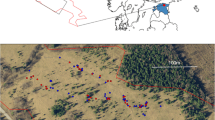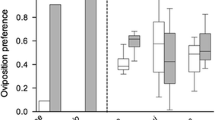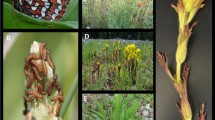Summary
The oviposition behaviour of the butterfly Anthocharis cardamines has been examined, using the methods of strong inference to investigate foodplant choice. Adaptive explanations for females ovipositing mainly on unshaded, young and large individuals of Alliaria petiolata are rejected in favour of explanations based on ‘apparency’ to searching females. Floral characters shown to influence intraspecific foodplant apparency are then examined in comparisons between crucifer species, and are shown to explain well the observed deposition of A. cardamines eggs. Cruciferae such as Barbarea vulgaris and Hesperis matronalis, although poor for larval survival, receive many butterfly eggs as a result of large, persistent inflorescences. The contrasting and opposing effects of hostplant apparency and defence are discussed.
Similar content being viewed by others
References
Atsatt P, O'Dowd AJ (1976) Plant defence guilds. Science 193:24–29
Bazzaz FA, Harper JL (1976) Relationship between plant weight and numbers in mixed populations of Sinapis alba L. and Lepidium sativum (L.) J Appl Ecol 13:211–217
Chew FS (1974) Strategies of foodplant exploitation in a complex of oligophagous butterflies. Ph D Thesis, Yale University
Chew FS (1977) Coevolution of Pierid butterflies and their cruciferous hostplants. II The distribution of eggs on potential foodplants. Evol 31:568–579
Chun MW, Schoonhoven LM (1973) Tarsal contact chemosensory hairs of the large white butterfly Pieris brassicae and their possible role in oviposition behaviour. Ent expl et appl 16:343–357
Clench H (1966) Behavioural Thermoregulation in butterflies. Ecology 47:1021–1034
Courtney SP (1980) Studies on the biology of the butterflies Anthocharis cardamines (L.) and Pieris napi (L.) in relation to speciation in Pierinae. Ph D Thesis, University of Durham, England
Courtney SP (1981) Coevolution of Pierid butterflies and their cruciferous foodplants. III Anthocharis cardamines (L.) survival, development and oviposition on different hostplants. Oecologia 51:91–96 (in prep). The Population biology of the Orange Tip butterfly, Anthocharis cardamines (L.) (Lep. Pier.) in northern England. submitted to Ecol Ent
Dempster JP, King ML, Lakhani FH (1976) The status of the swallowtail butterfly in Britain. Ecol Ent 1:71–84
Dethier VG (1959) Foodplant distribution and density and larval dispersal as factors affecting insect populations. Can Ent 91:581–596
Douwes P (1976) Activity in Heodes virgaureae in relation to air temperature, solar radiation and time of day. Oecologia (Berl) 21:1–17
Feeny P (1976) Plant apparency and chemical defence. Rec Adv in Phytochem 10:1–40
Fox RM (1966) Forelegs of butterflies. 1. Introduction; Chemoreception. J Res Lep 5:1–12
Gilbert LE (1975) Ecological consequences of a co-evolved mutualism between butterflies and plants. In: Gilbert and Raven (ed) ‘Co-evolution of Animals and Plants’. Texas Univ Press
Hodgson CJ (1978) The distribution and movement of apterous Myzus persicae on rapidly growing turnip plants. Ecol Ent 3:289–298
Hovanitz W (1963) The relation of Pieris virginiensis Edw to Pieris napi L. J Res Lep 1:124–134
Ilse D (1937) New observations on responses to colours in egg-laying butterflies. Nature 140:544–545
Ives PM (1978) How discriminating are cabbage butterflies? Aust J Ecol 3:261–276
Jefferson RG (1980) The phytophagous insect fauna of Mercurialis perennis L. MSc Dissertation, University of Durham, England
Jonasson J (1977) Frit fly, Oscinella frit L, oviposition on oat seedlings. Oikos 29:104–111
Jones RE (1977) Movement patterns and egg distribution in cabbage butterflies. J Anim Ecol 46:195–212
Jones RE, Ives PM (1980) The adaptiveness of searching and host behaviour in Pieris rapae (L). Aust J Ecol (in press)
Kennedy JS (1965) Mechanisms of hostplant selection. Ann Appl Biol 56:317–322
O'Dowd DJ, Williamson GB (1979) Stability conditions in plant defense guilds. Amer Nat 114:379–383
Opler PA (1974) Studies on the Nearctic Euchloe pt. VII. J Res Lep 13:1–20
Rausher MD (1979) Larval habitat suitability and oviposition preference in three related butterflies. Ecology 60:503–511
Rodman JE, Chew FS (1980) Phytochemical correlates of herbivory in a community of Native and Naturalized Cruciferae. Biochem Syst & Ecol, 8:43–50
Rothschild M, Schoonhoven LM (1977) Assessment of egg-load by Pieris brassicae. Nature 226:352–355
Saxena KM, Khuttar P (1977) Orientation of Papilio demoleus larvae in relation to size, distance and combination pattern of visual stimuli. J Insect Physiol 23:1421–1428
Schweitzer DF (1979) Effects of foliage age on bodyweight and survival in larvae of the tribe Lithophanini (Lep Noct). Oikos 32:403–408
Terofal F (1965) Zum problem der Wirtsspezifitat bei Pieriden (Lep) Mitt Munch Ent Gesell 55:1–76
Traynier RMM (1979) Long term changes in the oviposition behaviour of the cabbage butterfly Pieris rapae induced by contact with plants. Phys Ent 4:87–96
Verschaffelt E (1911) The cause determining the selection of food in some herbivorous insects. Proc Sci Acad Wet Amsterdam 3:536–542
Watanabe M (1979) Population dynamics of a pioneer tree Zanthoxylum ailanthoides, a hostplant of the swallow tail butterfly, Papilio xuthus. Res Popul Ecol 20:265–277
Wiklund C, Ahrberg C (1978) Hostplant, nectar source plants and habitat selection of males and females of Anthocharis cardamines. Oikos 31:169–183
Author information
Authors and Affiliations
Rights and permissions
About this article
Cite this article
Courtney, S.P. Coevolution of pierid butterflies and their cruciferous foodplants IV. Crucifer apparency and Anthocharis cardamines (L.) oviposition. Oecologia 52, 258–265 (1982). https://doi.org/10.1007/BF00363846
Received:
Issue Date:
DOI: https://doi.org/10.1007/BF00363846




